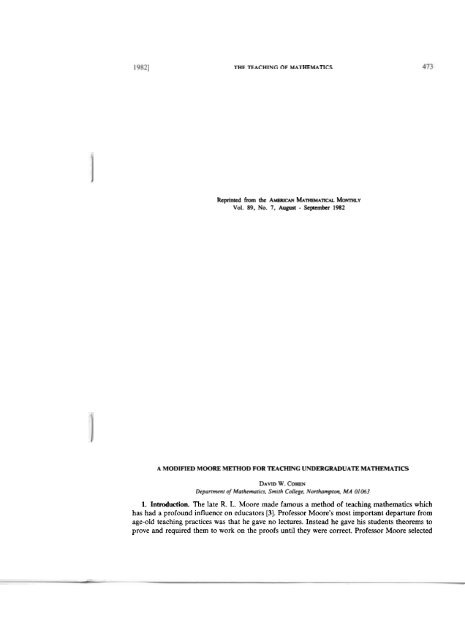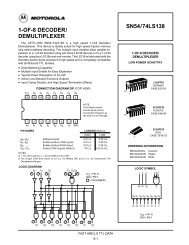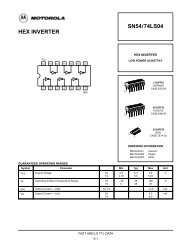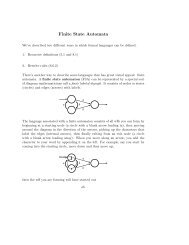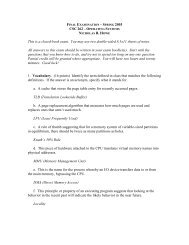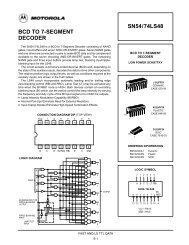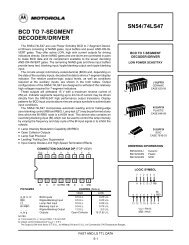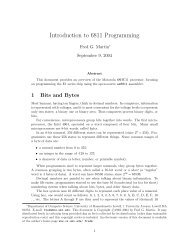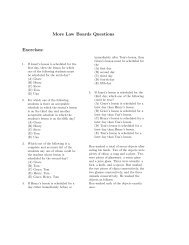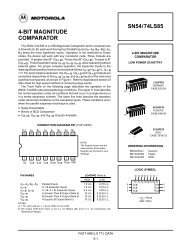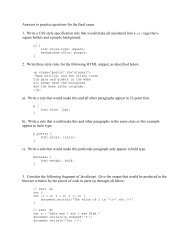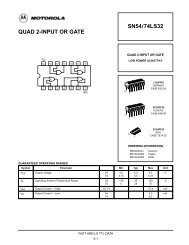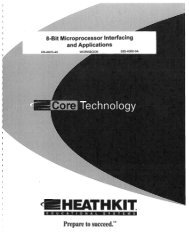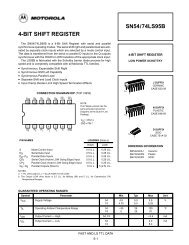Modified Moore method - Smith College
Modified Moore method - Smith College
Modified Moore method - Smith College
Create successful ePaper yourself
Turn your PDF publications into a flip-book with our unique Google optimized e-Paper software.
THE TEACHING OF MATHEMATICS<br />
Reprinted from the AMERICAN MATHEMATICAL MONTHLY<br />
Vol. 89, No. 7. August - September 1982<br />
A MODIFIED MOORE METHOD FOR TEACHING UNDERGRADUATE MATHEMATICS<br />
DAVID W. COHEN<br />
Department of Mathematics, <strong>Smith</strong> <strong>College</strong>. Northampton. MA 01063<br />
1. Introduction. The late R. L. <strong>Moore</strong> made famous a <strong>method</strong> of teaching mathematics which<br />
has had a profound influence on educators [3]. Professor <strong>Moore</strong>'s most important departure from<br />
age-old teaching practices was that he gave no lectures. Instead he gave his students theorems to<br />
prove and required them to work on the proofs until they were correct. Professor <strong>Moore</strong> selected
474 DAVID W. COHEN<br />
those who would take his graduate course from a list of students eager to participate. and many of<br />
his students became excellent productive mathematicians.<br />
When the "<strong>Moore</strong> <strong>method</strong>" was attempted by others at the undergraduate level, however, the<br />
results often were disappointing. Instructors of undergraduates usually cannot handpick their<br />
students. Moreover, undergraduates normally have not had the experience proving theorems and<br />
writing mathematics necessary for meaningful progress without help from an instructor. Finally,<br />
the <strong>Moore</strong> <strong>method</strong> sometimes creates an unhealthy atmosphere of competition and isolation<br />
among students.<br />
Recently, Professor <strong>Moore</strong>'s philosophy of shifting the focus from instructor to student has<br />
been incorporated in a wide variety of teaching <strong>method</strong>s, which are more successful for<br />
undergraduate courses. (See [4] and [S].) The <strong>method</strong> I describe here has worked very well and is<br />
the most comprehensive program I have seen for introducing a <strong>Moore</strong>-type <strong>method</strong> to undergraduate<br />
teaching.<br />
Although this <strong>Modified</strong> <strong>Moore</strong> <strong>method</strong> was developed to teach mathematics, it is based on<br />
principles that apply to the teaching of most subjects.<br />
1. Students understand better and remember longer what they discover themselves than what<br />
is told to them.<br />
2. People master an idea most thoroughly when they teach it to someone else.<br />
3. Effective writing and clear thinking are inextricably linked.<br />
The following objections usually arise when one thinks about teaching <strong>method</strong>s devised to put<br />
these principles into practice.<br />
I. The truths taught in most courses took great thinkers many years to discover. We cannot<br />
expect our students to discover them all in one semester. Further, the amount of the<br />
material we cover in our wurses is at a minimum and should not be reduced.<br />
2. It might be wonderful training for students to try to teach what they have just learned, but<br />
pity the poor student who must learn from such a teacher.<br />
3. Yes, we wince at some of the writing we get from students, but we are not teaching writing<br />
courses. We do not have the time or the training to teach writing. The serious students will<br />
learn to write when they get to graduate school and read journals. If their writing is fuzzy,<br />
we can test their understanding with short-answer questions.<br />
The <strong>Modified</strong> <strong>Moore</strong> <strong>method</strong>, based on the principles stated above, answers these objections.<br />
In brief, the <strong>method</strong> divides a class into small groups, each of which is responsible for a weekly<br />
question. Over the course of a week each small group will study and answer the question, write a<br />
short paper presenting the answer, and prepare to teach the question and its answer to the rest of<br />
the class. The questions and their answers contain all the ideas wvered in the course.<br />
2. Preparation and Scheduling for the Course. The first task for the instructor is to break the<br />
course material into a list of questions. These may resemble questions asked on a take-home<br />
examination at the end of the course. Some examples of questions for a course in real analysis are<br />
provided in the Appendix. An average student with some coaching from the instructor should be<br />
able to understand a question and write an answer to it in one week. There should be enough<br />
questions so that any student who can answer all of them thoroughly will have mastered all the<br />
material for the course. The number of questions should be about two or 24 times the number of<br />
weeks alloted for the course. This number will provide weekly allotments of two or three questions<br />
per week and allow three weeks to be reserved for organizing the class and giving examinations.<br />
The next task is to compile a list of bmics that the students must understand to answer the<br />
questions. These are usually definitions or axioms or theorems from other courses. In the<br />
[Continued on p. 487.1
THE TEACHING OF MATHEMATICS 487<br />
Appendix I have provided examples of basics as well as questions. .<br />
With the <strong>Modified</strong> <strong>Moore</strong> <strong>method</strong> the class is scheduled to meet as an entire class once a week<br />
for class meetings of 90 to 110 minutes. It does not work well to substitute two 50-minute class<br />
meetings for the one longer meeting, since ample time is required for students to ask questions<br />
about small points. Furthermore, the questions for the week are often intimately related and are<br />
better discussed in a single meeting. Two other hours on two separate days each week are then<br />
scheduled for coaching sessions.<br />
3. Organizing the Class and Assigning Work. The first day of class is devoted to a thorough<br />
explanation of the <strong>method</strong>, its objectives, and what is expected of the students.<br />
The class is then divided into teams of two or three students each. Teams of three work best.<br />
These do not change until midterm when all teams must change for the second half of the term.<br />
New teams are assigned to avoid those consisting only of weak or only of strong students.<br />
At the end of each class meeting the instructor assigns questions for the next class meeting.<br />
Several teams may be assigned the same question. After assigning the questions, the instructor<br />
announces the schedule for the first coaching session.<br />
The assignment is to work as a team to: 1) understand the question, 2) find the answer, and 3)<br />
write a short paper presenting the question and its answer. This paper will be duplicated and<br />
distributed to all members of the class. In addition, each team must be prepared to explain to the<br />
class its question and the answer it has found. All teams are expected to be prepared for each class<br />
meeting, although only one team per question will be called upon to make an oral presentation.<br />
4. The Coaching Sessions. The first coaching session follows the class meeting by one or two<br />
days. Each team is required to come during that part of the first coaching session dealing with its<br />
question. If several teams are dealing with the same question, all of those teams come at the same<br />
time. Each team is expected to have met once prior to this session to try to understand the basics<br />
and the question and to formulate ideas about the answer.<br />
When students have discovered the answer before the session, the instructor simply listens to<br />
the team's answer and provides whatever help is necessary to make the team's explanation very<br />
clear. When a team comes in a state of confusion, on the other hand, the instructor must do some<br />
explaining. In the 20 or 30 minutes devoted to each question, he must try to lead the students to<br />
the heart of the matter, using a Socratic style as long as time permits it. Sometimes this means<br />
asking one or two questions to help students understand how they almost had the idea themselves.<br />
At other times it means giving a complete explanation, and hoping that the students will make a<br />
discovery on some other questions. I try to make sure that at least one member of each team has a<br />
basic understanding before the teams leave.<br />
The second coaching session follows the first by three days or more. During those days the<br />
students prepare drafts of their papers. The teams meet and discuss the work and a team might<br />
even agree on a rough written draft of its paper. Each member must then write his or her own<br />
draft without consultation.<br />
All teams gather for the second coaching session during which students exchange their drafts<br />
- with their teammates for peer review. The reviewers pay close attention to content, clarity and<br />
style, and make suggestions for improvement.<br />
While this peer review is taking place, the instructor selects drafts at random and reviews them<br />
in front of the team. This provides at least one team member with professional comment on a<br />
draft, and at the same time gives each member a chance to watch how the instructor reviews. I<br />
reserve some time to speak to the class as a whole about common errors or misconceptions found<br />
during my reviews.<br />
5. The Weekly Papers. Each paper must consist of a clear, concise, cogent answer to the<br />
team's question for the week, written in a style appropriate to the subject for the course, and with<br />
careful attention to syntax, punctuation and correct usage of notation commonly used by
488 DAVID W. COHEN [ August-Sep tember<br />
professionals in the subject.<br />
Each paper must begin with an abstract of two or three sentences revealing the key idea in the<br />
paper. Students perform a task important for clear understanding when they distill a long<br />
argument into two or three essential sentences.<br />
Each team decides how the paper is to be written. Sometimes the students divide a paper into<br />
sections with each member responsible for writing a section. Sometimes a single student writes the<br />
entire paper; however, that student may not write another one until the other members of the<br />
team have also written an entire paper.<br />
6. The Class Meetings. At the beginning of the class meeting each team passes a copy of its<br />
paper out to all students. Two copies go to the instructor, one to be corrected and returned. The<br />
team called upon for the first question for the week then makes its presentation. Each team must<br />
plan its presentation and allow time for questions from the class. Usually each member is<br />
responsible for one part of the presentation.<br />
The instructor's role during the presentation is a delicate matter. If there is a point that seems<br />
unclear to me, I wait for a student to ask about it; but if no one does, then I ask. I am willing to<br />
help a team clarify an explanation, but only after I sense that no one else can do it. With this<br />
<strong>method</strong> students are much less willing to let the instructor dominate discussion than in more<br />
conventional classes. They have invested much time and energy in their preparation, and are<br />
anxious to explain their ideas clearly to their classmates.<br />
7. Evaluating Student's Work. The instructor should try to read each team's paper carefully<br />
and return the papers the day after they are received. He should correct grammar and style as well<br />
as content.<br />
The <strong>Modified</strong> <strong>Moore</strong> <strong>method</strong> calls for two comprehensive written examinations; one at<br />
midterm and one at the end of the course. Students take these as individuals, not as teams.<br />
Everyone is responsible for all the material discussed in class meetings, including material the<br />
instructor may have provided on the spur of the moment to clarify or amplify an idea.<br />
8. The Method at <strong>Smith</strong> Cdlege. I have successfully used the <strong>Modified</strong> <strong>Moore</strong> <strong>method</strong> to<br />
teach courses at all levels at <strong>Smith</strong>: a course on "The Infinite" for nomathematics majors, a<br />
course on Hilbert spaces for senior mathematics honors students, as well as standard intermediate-level<br />
courses. The <strong>method</strong> has worked well with classes having as few as 5 students and as<br />
many as 25. I suspect that it would not work very well for classes much over 25 because the<br />
coaching sessions would be too large to allow time for the Socratic approach.<br />
Students are encouraged to consult appropriate text books, which I place on reserve at the<br />
library. Sometimes I even cite the pages of a book that contain the answer to a question for the<br />
week. To read the answer a student must understand the author's notation and refer back to<br />
results the author has proved earlier to see if those results have been proved in our class.<br />
I grade papers and oral presentations either "O", "I", or "2". Most grades are "l", which<br />
indicates satisfactory work. A grade of "2" indicates an unusually impressive piece of work. A<br />
grade of "0" indicates that the paper missed the idea altogether. Every member of a team receives<br />
the same grade for that team's paper, but members receive individual grades for their part in an<br />
oral presentation.<br />
9. Conclusions. The objections cited in section 1 can now be refuted.<br />
The <strong>Modified</strong> <strong>Moore</strong> <strong>method</strong> incorporates the principle of student discovery without undue<br />
sacrifice in amount of material covered. While each student grapples each week with only one<br />
question, other students are dealing with other questions, so that the total amount of material<br />
covered by the class in one week is roughly equal to that which would be covered by lectures. I am<br />
convinced by students' performance on examinations that the total amount of material students<br />
master in courses taught by the <strong>Modified</strong> <strong>Moore</strong> <strong>method</strong> is at least as great as the amount they<br />
master in lecture courses.
19821 THE TEACHING OF MATHEMATICS 489<br />
The <strong>method</strong> effectively raises the level of communication between students. Since all students<br />
are responsible for all questions on examinations, the presenting teams try hard to teach and the<br />
other students demand the clarity they need in order to learn.<br />
Since students write every week and receive prompt evaluation of their writing, they make<br />
substantial improvement. They also learn to appreciate the connection between understanding a<br />
subject and writing about it.<br />
Furthermore. most students respond wel! to the responsibility placed on them by the <strong>Modified</strong><br />
<strong>Moore</strong> <strong>method</strong>. They are willing to work hard for a teacher who pays attention to their thinking<br />
and writing. I find that the percentage of students who drop courses taught by the <strong>Modified</strong><br />
i <strong>Moore</strong> <strong>method</strong> because they are burdensome is no higher than the percentage who drop other<br />
courses for that reason. Most students are stimulated by the change from passive to active<br />
1, learning.<br />
Appendix. Below is a sample syllabus and the basics and questions for class meeting number<br />
six for the course Introductory Real Analysis taught for four years at <strong>Smith</strong> <strong>College</strong> by the<br />
<strong>Modified</strong> <strong>Moore</strong> <strong>method</strong>. The course is for sophomore and junior mathematics majors. The<br />
prerequisites are Multidimensional Calculus and Linear Algebra. There are ten weeks available for<br />
class meetings out of the 13-week semester and the total number of questions for the course is 27.<br />
Week<br />
1. Orientation<br />
2. Class meeting 1: Metrics; completeness of the reals; open and closed subsets of the reals.<br />
3. Class meeting 2: Limit points; Bolzano-Weierstrass Theorem.<br />
4. - 3: Continuity of functions, introduction.<br />
5. - 4: Continuity of functions, sums, products, compositions, examples.<br />
6. - 5: Differentiability of functions.<br />
7. - 6: Cauchy sequences of reds; pointwise and uniform convergence of sequences<br />
of functions.<br />
8. Examination<br />
9. Class meeting 7: Theorems on uniformly convergent sequences of functions; Weierstrass<br />
M-Test.<br />
10. - 8: Analytic functions; Taylor's Theorem.<br />
11. - 9: Lebesgue measure, introduction.<br />
12. - 10: Lebesgue integral, introduction.<br />
1 3. Examination<br />
i<br />
I<br />
L<br />
Basics for Class Meeting Six. (Week 7)<br />
DEFINITIONS: a Cauchy sequence of real numbers, the limit of a sequence of real numbers, the<br />
pointwise limit of a sequence of functions, the uniform limit of a sequence of functions.<br />
Questions for Class Meeting Six. (Week 7)<br />
1. Show that the sequence of functionsf,(x) = xn converges pointwise but not uniformly on<br />
[O. I] to the function<br />
2. Show that the sequence of functions f,(x) = I - xn converges uniformly on [-p, p] for<br />
anyp with lplc 1.<br />
References<br />
1. J. Gersting and J. Kuczkowski. Why and how to use small groups in the mathematics classroom. Two-year<br />
Coll. Math. J.. 8 (1977) 270-74.
490 ROBERT B. REISEL [August-September<br />
2. P. R. Halmos. E. E. Moise, and G. Piranian. The problem of learning to teach. this MONTHLY. 82 (1975)<br />
466-476.<br />
3. F. Burton Jones, The <strong>Moore</strong> <strong>method</strong>, this MONTHLY. 84 (1977) 273-8.<br />
4. J. A. Murtha, The apprentice system for math <strong>method</strong>s, this MONTHLY. 84 (1977) 473-6.<br />
5. Warren Page. A small group strategy for enhanced learning. this MONTHLY. 86 (1979) 856-8.<br />
6. J. Weinglass, Small groups: an alternative to the lecture <strong>method</strong>, Tweyear Coll. Math. J.. 7 (1976) 15-20.


